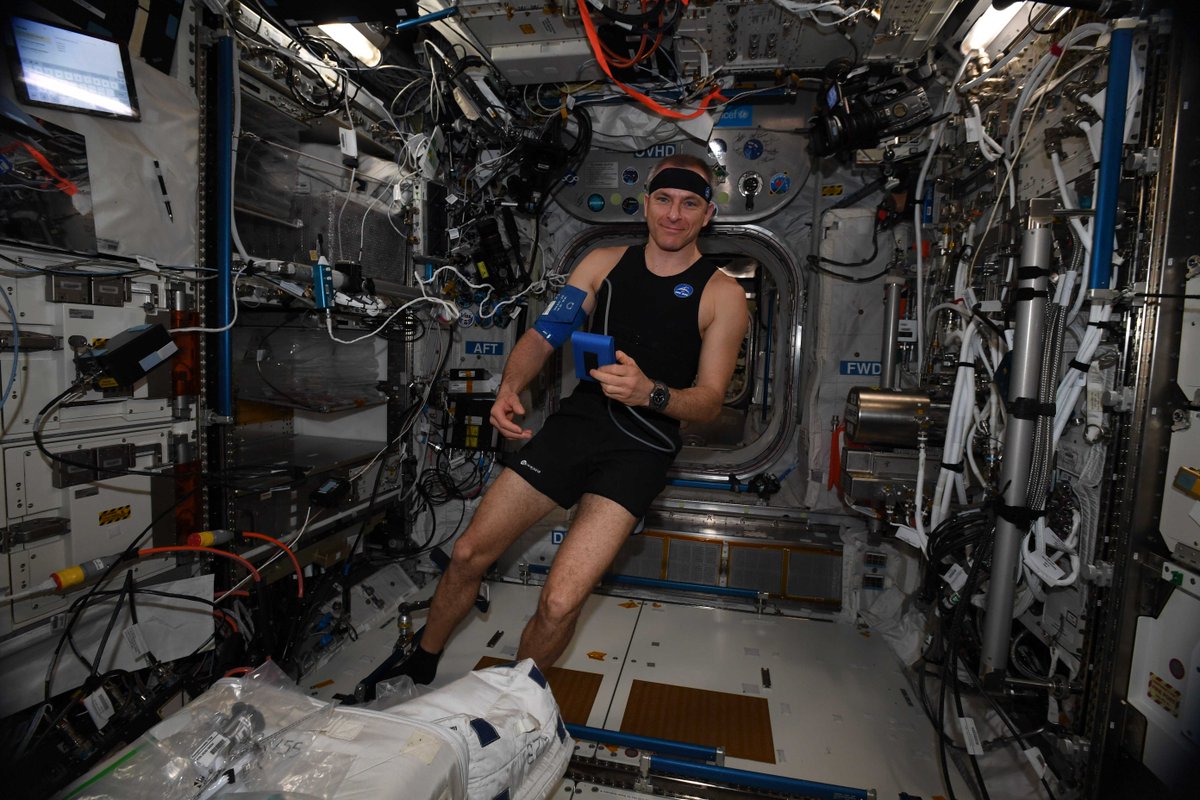Final Frontier Medicine: Astronauts Use 'Smart Shirt' and Ultrasounds to Monitor Health

OTTAWA, Ontario — Fans of "Star Trek" know of the iconic tricorder that could take the measure of just about any vital sign for the spacefarers. Although astronauts on the International Space Station don't have access to this futuristic technology (yet), they are testing out devices like a shirt that measures heartbeat, temperature and blood pressure, according to an astronaut currently in orbit.
Canadian astronaut David Saint-Jacques spoke with schoolchildren and media yesterday (Feb. 7) at the Canada Aviation and Space Museum via a brief downlink, answering questions such as how radiation affects spacefarers and how astronauts stay healthy in space. Microgravity is a nasty problem for astronauts, he explained while floating in the Japanese Kibo laboratory. Astronauts must spend roughly 2 hours a day exercising their cardiovascular and muscular systems to stave off weakness and damage.
While the station isn't full of gee-whiz technology like audiences saw in "Star Trek," Saint-Jacques said, there are a few innovative technologies on the orbiting lab. One is a "smart shirt" called Bio-Monitor, whose development was led by Montreal's Carré Technologies. Its goal is to combine the functions of several devices, while remaining unobtrusive enough for astronauts to wear while sleeping and exercising. The shirt automatically monitors the astronaut's vital signs and then transmits the information to Earth. [Expedition 58: The International Space Station Mission in Pictures]
"We hope that [it] will become a very common product," Saint-Jacques told Space.com during a publicly broadcast question-and-answer session with media. And he didn't just mean in space. "It would be very useful for people who are deployed [in the military] … or people who are stuck at home, [where] it is difficult to go to the hospital. They could have their health checked remotely."
Most of the other ISS medical equipment is "pretty conservative," although sometimes doctors get creative trying to use stuff that's already on the space station to monitor health problems, he added. Then, those creative solutions can get used back on Earth, too.
"We scratch our heads and we invent new methods on station that we then use on the ground," said Saint-Jacques, who is a medical doctor himself. "For example, a couple of years ago, people started to think, 'Hm, we don't have an X-ray machine here in space. How could we figure out if somebody has a hole in their lungs … without an X-ray machine?'
"So we figured out a way in space, using an ultrasound machine, because that's what we had," he continued. Now, that's standard practice for many doctors. "Now, that's what we do on Earth to look for punctured lungs. We use an ultrasound machine."
Breaking space news, the latest updates on rocket launches, skywatching events and more!
New exhibit
Saint-Jacques' call from space coincided with the opening of a new exhibit at the museum, "Health in Space: Daring to Explore." The traveling exhibit discusses several Canadian astronauts who journeyed to space. In addition, the attraction includes artifacts such as pictures of Saint-Jacques when he was a doctor working in Canada's north, a sample Bio-Monitor shirt and an example of the Microflow experiment on blood-sampling technology that flew with Canadian astronaut Chris Hadfield during his Expedition 34/35 mission in 2012-13.
Retired Canadian astronaut Robert Thirsk attended the event and gave a quick tour of the exhibit to a small group of children, explaining how the artifacts on display were used in spaceflight. During the tour, he paused in front of an exhibit talking about how gravity affects astronauts.
"This is me in space," he said, pointing to a picture of himself in 2009, during Expedition 20/21. "I wear glasses for reading, and my first month in space, I realized I couldn't see as well as I did on the ground. I talked to one of my crew mates, and he said he was also having vision problems. I could see distance, but [when] reading documents up close, I was having difficulty." [The Human Body in Space: 6 Weird Facts]
The vision problem, which Thirsk played a role in discovering, still troubles NASA a decade later. What the agency knows for sure are the effects: Pressure on the back of the eye pushes the back end of the eye in and causes a change in the focal distance, affecting the astronaut's ability to read in space, among other things. No one knows exactly how the vision problems are happening, but NASA is investigating. One strong suspect is the lack of a day-night pressure cycle inside astronaut skulls when they're in space.
Saint-Jacques' mission will examine a suite of Canadian medical technologies. These include Bio-Analyzer (which will do near-real-time blood analysis), MARROW (which will investigate whether microgravity causes fat accumulation in blood marrow) and MicroPrep (which samples body fluids to look for macromolecules such as DNA).
Follow us @Spacedotcom and Facebook. Original article on Space.com.

Elizabeth Howell (she/her), Ph.D., was a staff writer in the spaceflight channel between 2022 and 2024 specializing in Canadian space news. She was contributing writer for Space.com for 10 years from 2012 to 2024. Elizabeth's reporting includes multiple exclusives with the White House, leading world coverage about a lost-and-found space tomato on the International Space Station, witnessing five human spaceflight launches on two continents, flying parabolic, working inside a spacesuit, and participating in a simulated Mars mission. Her latest book, "Why Am I Taller?" (ECW Press, 2022) is co-written with astronaut Dave Williams.


